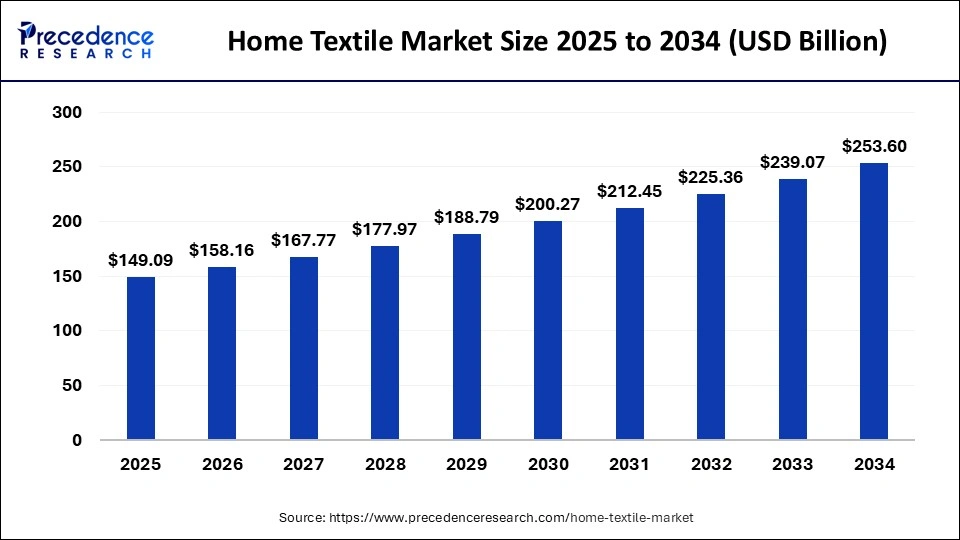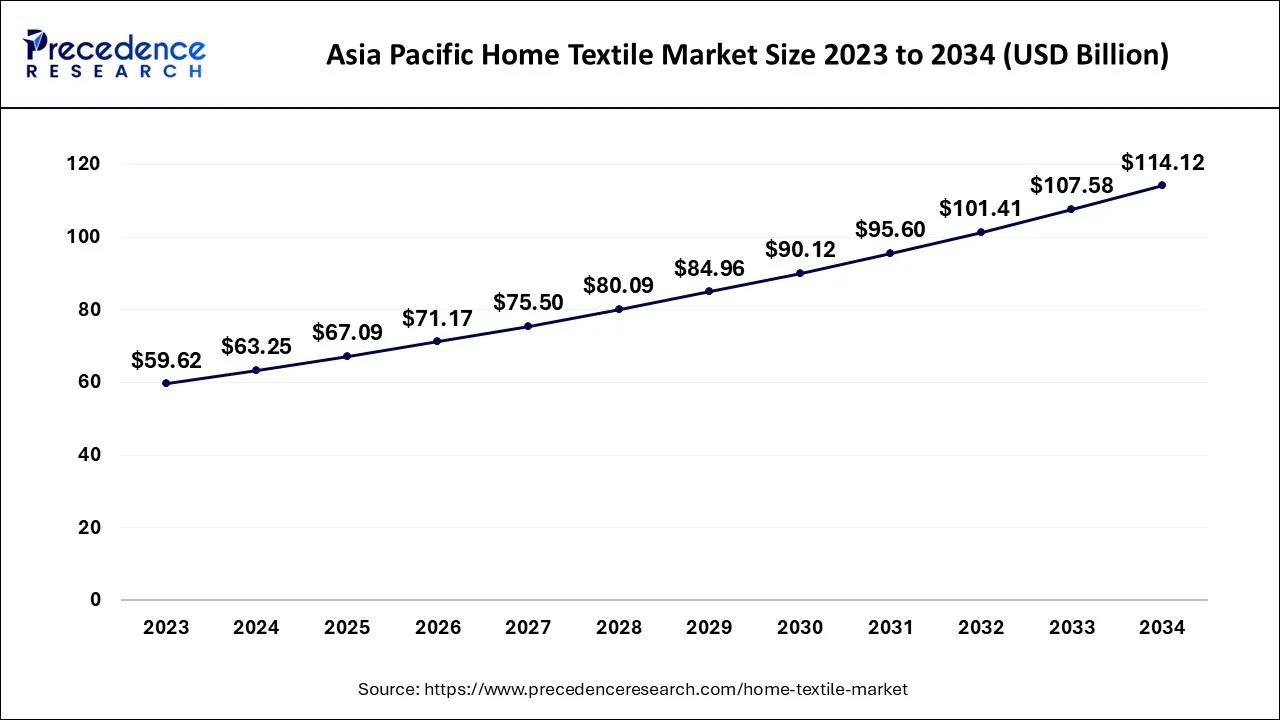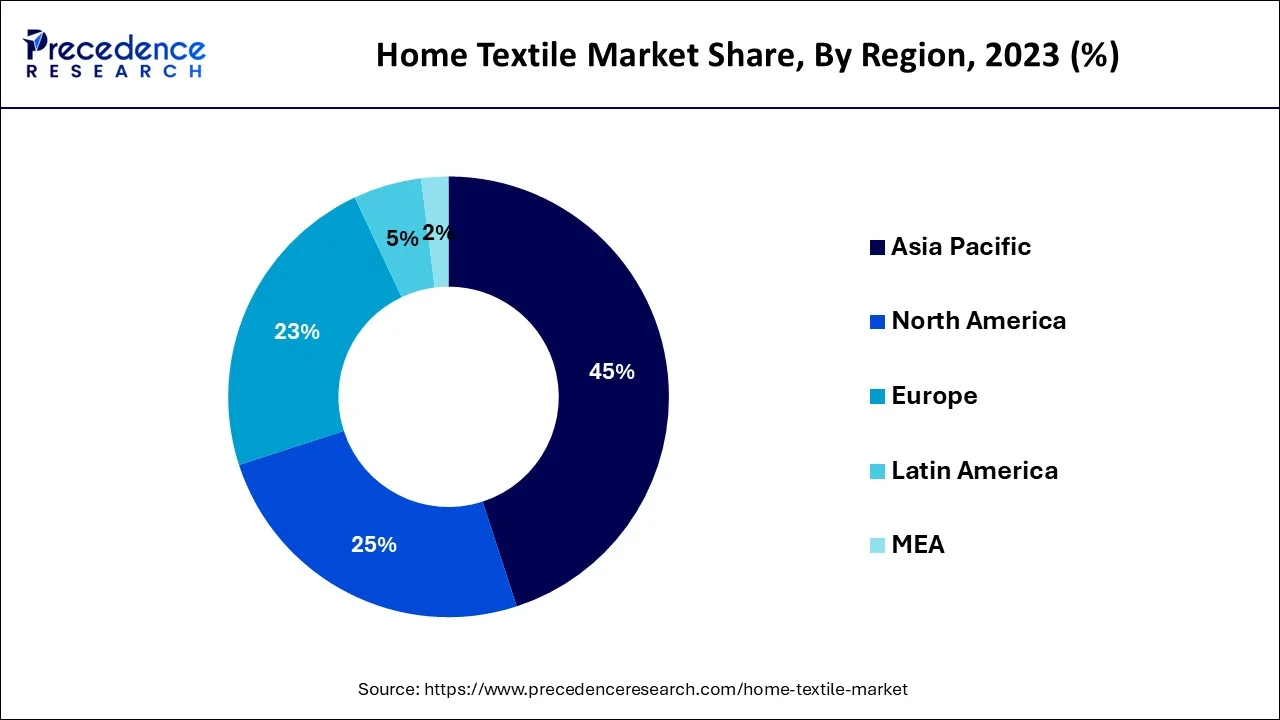April 2025
The global home textile market size accounted for USD 140.55 billion in 2024, grew to USD 149.09 billion in 2025 and is projected to surpass around USD 253.60 billion by 2034, representing a healthy CAGR of 6.08% between 2024 and 2034.
The global home textile market size is estimated at USD 140.55 billion in 2024 and is anticipated to reach around USD 253.60 billion by 2034, expanding at a CAGR of 6.08% between 2024 and 2034.

The global home textile market size accounted for USD 63.25 billion in 2024 and is predicted to be worth around USD 114.12 billion by 2034, growing at a CAGR of 6.07% from 2024 to 2034.

Asia Pacific dominated the market with the largest market share in 2023, the region will continue to grow at a significant rate during the forecast period. The growth of the market is attributed to the increasing population in this region. The rising population results in the demand for day-to-day essential home accessories needs these will rise in the trends in the demand for the home textiles products. The increasing income of consumers in the nation like India, China, and Japan will rise the lifestyle of the consumers resulting in substantial growth for the market.
In addition, the booming e-commerce market in Asia Pacific supplements the growth of the market, multiple companies or producers of linen and textile products are focusing on their online presence for global expansion and consumer convenience. This element will act as a growth factor for the market.

North America is expected to hold a significant market share in the forecast period. The growth of the market in the region is rising due to the changing rising lifestyle of the consumers, which will result in a higher demand for the market. The rising inclination towards sustainable products and goods impacted the growth of the market in this region. The presence of major manufacturing units in the home textile industry, especially in the United States propel the growth of the market.
Moreover, the willingness of spending on premium/luxury household linen products highlights the growth of the market in North America. The overall pace of business in the region along with a considerable demand for home textile products is expected to propel the market’s growth during the forecast period.
According to the United States National Council of Textiles Organization, the shipments of textiles in the United States reached $65.8 billion in 2022.
The home textile market revolves around the production, innovation, and distribution of textile products that are utilized in the home, either for aesthetic or practical reasons. Home textiles are produced using a wide range of natural and synthetic materials and come in an infinite number of hues, patterns, and designs. The term "home textile," also known as "household textile," refers to a subset of technical textiles that include textiles used in domestic settings, such as upholstery, carpeting, sun protection, cushion materials, floor and wall coverings, and textile-reinforced structures and fixtures. Bed and bath linen, kitchen and tableware, carpets and rugs, curtains, and other interior décor items are all examples of home textiles. The most popular types of home textiles are bedding (like sheets, blankets, and comforters), towels (like bath, hand, and face towels), curtains and drapes, rugs, upholstery fabrics (like furniture slipcovers and pillows), and table linens (like placemats, napkins, and tablecloths). Wall hangings throws, and quilts are a few more common varieties of household textiles.
The market for home textiles and decorating materials is wide and diverse in terms of costs, patterns, and styles. While customers in the mid-and economy segment prefer large quantities of items at affordable prices, consumers in the wealthy sector have sophisticated worldwide tastes in terms of quality and style, without regard to price. The global home textiles market is expected to grow at a noticeable rate with the penetration of home textiles products on e-commerce platforms. This element also offers a global platform for multiple manufacturers to expand in the competitive market.
| Report Coverage | Details |
| Market Size in 2024 | USD 140.55 Billion |
| Market Size by 2034 | USD 253.60 Billion |
| Growth Rate from 2024 to 2034 | CAGR of 6.08% |
| Largest Market | Asia Pacific |
| Base Year | 2023 |
| Forecast Period | 2024 to 2034 |
| Segments Covered | By Product, By Product, and By Distribution Channel |
| Regions Covered | North America, Europe, Asia-Pacific, Latin America, and Middle East & Africa |
Changing lifestyle preferences
The increasing population and growing urbanization globally boost the trend of lifestyle standards. The growing inclination towards maintaining a lifestyle in society will raise spending on luxury products and goods. Home textiles are one of the luxuries and essential things in the day-to-day lifestyle. Home textile includes each and every textile or fabric that can be useful in home decor. The home textiles include the bed, curtains, pillows, covers, etc. They also include fancy curtains, decorative pillows glamorous sofas, etc. Increasing spending tendency in the lifestyle will boost the growth of the home textiles market.
Higher prices may constraints the market demand
There are several varieties of home textiles in the market but the higher competition in the brands of the market may hamper the demand of the market. Though home textiles are now considered luxury products and sometimes they cannot be afforded by every other consumer. The continuous fluctuations in the raw material prices also affect the final price of the product. Along with this, the supply chain and logistics factors also boost the final price, which changes consumer behavior. Thus, the higher price of the textiles is observed to hinder the growth of the market.
Booming e-commerce market across the globe
The rise of the e-commerce industry across the globe is observed to serve multiple opportunities for the home textiles market. E-commerce platforms allow home textile companies to reach customers worldwide, breaking down geographical barriers. Online marketplaces provide access to a broader customer base, enabling businesses to expand their reach and target consumers in different regions and countries. E-commerce offers convenience to both businesses and consumers. Customers can browse and purchase home textile products from the comfort of their homes, without the need to visit physical stores. This convenience factor has contributed to the growth of online shopping for home textiles.
The bedroom linen home textile segment dominated the market with the largest market share in 2023. The growth of the segment is attributed to the increase in the shifting living standards of the consumer. In the bedroom linen, soft and comfortable materials are used for a better experience. The material that is used in the bedroom linen is acrylic, wool, polyester, or a mix of these fibers. In bedroom linen, the nylon-based blend is often used. The bedroom linen can be made of lightweight fabric with different colors and designs. The preferences towards luxury linen products, especially for bedrooms promote the growth of the segment.
The bathroom linen home textiles segment is expected to grow at a significant market share in the forecast period. The growth of the segment is attributed to the increase in the hospitality sector. The higher demand for bathroom linen accessories in the hospitality industry for consumers is expected to rise in the demand of the market. Bathroom linen textiles can be used in urban households and in some rural households also.
The polyester home textiles segment dominated the market with the largest market share in 2023. The demand for long-lasting house linen and textile products has boosted the growth of the polyester segment. The polyester material offers durability, most of them offer no-wrinkled texture and they are easily washable. These elements promote their application in the market. Polyester material is mostly used for the making of curtains, bedding, and upholstery.
The offline segment dominated the market with the highest market share in 2023. The growth of the segment is attributed to the increase in the supermarket and hypermarkets in the urban areas. The manufacturers of the home textile industry are interested in the offline distribution channel for better reach to the consumers. The presence of home textiles and linen stores in malls along with the consumer preferences for buying linen products physically for quality check fuel the growth of the segment.
The online segment is expected to dominate the market with the highest market revenue in the forecast period. Increasing inclination toward the online distribution channel of consumers will result in a higher demand for the home textile market. Increasing e-commerce trends worldwide will be anticipated to increase the growth of the market. The increasing interest of the millennial generation in online shopping will increase the trend of online segment growth.
Segments Covered in the Report:
By Product
By Material
By Distribution Channel
By Geography
For inquiries regarding discounts, bulk purchases, or customization requests, please contact us at sales@precedenceresearch.com
No cookie-cutter, only authentic analysis – take the 1st step to become a Precedence Research client
April 2025
January 2025
February 2025
March 2025